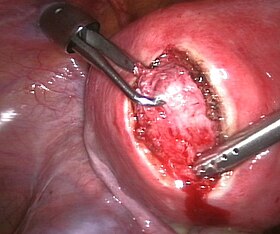Uterine myomectomy
This article needs more primary sources. (February 2022) |  |
| Uterine myomectomy | |
|---|---|
 A laparoscopic myomectomy: The uterus has been incised and the myoma is held and about to be shelled out. | |
| Other names | Fibroidectomy |
| ICD-9-CM | 68.29 |
Myomectomy, sometimes also called fibroidectomy, refers to the surgical removal of
Indications
The presence of a fibroid does not mean that it needs to be removed. Removal is necessary when the fibroid causes pain or pressure, abnormal bleeding, or interferes with reproduction. The fibroids needed to be removed are typically large in size, or growing at certain locations such as bulging into the endometrial cavity causing significant cavity distortion.
Treatment options for uterine fibroids include observation or medical therapy, such a
Procedure
A myomectomy can be performed in a number of ways, depending on the location, size and number of lesions and the experience and preference of the surgeon. Either a general or a spinal anesthesia is administered.
Laparotomy
Traditionally a myomectomy is performed via a laparotomy with a full abdominal incision, either vertically or horizontally. Once the peritoneal cavity is opened, the uterus is incised, and the lesion(s) removed. The open approach is often preferred for larger lesions. One or more incisions may be set into the uterine muscle and are repaired once the fibroid has been removed. Recovery after surgery takes six to eight weeks.
Laparoscopy
Using the laparoscopic approach the uterus is visualized and its fibroids located and removed. Studies have suggested that laparoscopic myomectomy leads to lower
Hysteroscopy
A fibroid that is located in a submucous position (that is, protruding into the endometrial cavity) may be accessible to hysteroscopic removal. This may apply primarily to smaller lesions as pointed out by a large study that collected results from 235 patients with submucous myomas who were treated with hysteroscopic myomectomies; in none of these cases was the fibroid greater than 5 cm.[4] However, larger lesions have also been treated by hysteroscopy.[5] Recovery after hysteroscopic surgery is but a few days.
Complications and risks
Complications of the surgery include the possibility of significant blood loss leading to a
It may not be possible to remove all lesions, nor will the operation prevent new lesions from growing. Development of new fibroids will be seen in 42–55% of patients undergoing a myomectomy.[7]
It is well known that myomectomy surgery is associated with a higher risk of
To reduce bleeding during myomectomy, the use of
Myomectomy during pregnancy
Leiomyomata tend to grow during pregnancy but only the large ones causing endometrial cavity distortion could interfere with the growing pregnancy directly.[10] Generally, surgeons tend to stay away from operative interventions during the pregnancy because of the risk of haemorrhage and the concern that the pregnancy may be interrupted. Also, after a pregnancy, myomas tend to shrink naturally. However, in selected cases myomectomy may become necessary during pregnancy, or also at the time of a caesarean section to gain access to the baby.[11]
